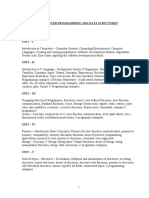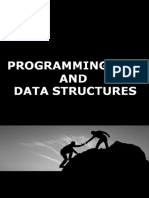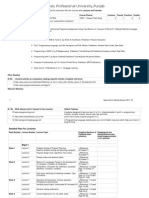CSA02 C Programming Syllabus 20200504081112
Uploaded by
Gnana SekharCSA02 C Programming Syllabus 20200504081112
Uploaded by
Gnana SekharCSA02 C PROGRAMMING 3 0 2 4
Prerequisite NIL
Course The course on C programming aims to provide the students with the following
Objectives 1. To familiarize the basic concepts of computer programming.
1. To provide knowledge on syntax and semantics of “C” language.
2. To learn how to write modular and readable C Programs
3. To write programs using structured programming approach to solve problems
4. To provide training in writing efficient, maintainable and portable code.
Course On successful completion of the course, the student will be able to:
Outcomes 1. Apply fundamental syntax rule for declaring variables, constants, primitive
data types and choose appropriate conditional and iterative constructs for a
given programming task.
2. Use non-primitive data types such as arrays and strings
3. Design and implement code using functions with various parameter passing
methods, pointers and allocate memory with dynamic memory allocation
functions.
4. Develop programs using user defined data types such as structures and
unions.
5. Design applications for sequential and random processing of files.
UNIT I INTRODUCTION TO C
Programming basics - C programming history - Structure of C program- Pre- processor
directives - Constants, Variables and Data Types – Operators and Expressions – Problems using
operators - Operator precedence and associativity of operators - Decision Making and Branching
–Looping – Problems using Branching & control statements.
UNIT II ARRAYS
Defining and processing arrays - Using different data types, indexes and access to arrays. –
Single dimensional arrays – Two dimensional arrays- -Multi-dimensional arrays – programs
using arrays- Array applications: Search in sorted and unsorted data and merging of arrays –
Sorting algorithms.
UNIT III FUNCTIONS AND POINTERS
Functions – Types - Declaring, defining and accessing functions – Parameter passing methods –
Prototypes -Programs using functions -– Recursion – String handling –Pointers – Declaration –
Operations on pointers -Accessing variable through pointer – Initializing pointer variable –
Pointers and Functions – Pointers and Arrays – Example programs using pointers with function
& arrays–Command line arguments – Dynamic memory allocation.
UNIT IV STRUCTURES AND UNIONS
Structures–structure definition – Structure declaration –Structure within a structure - Programs
using structures- Structure Pointers-Union - Programs using Unions - Storage classes – auto,
extern, static and register.
UNIT V FILES & OPERATIONS
File structure- File pointer – file operations – Opening and closing of file – Creating, Processing
and updation on files- File handling programs- Case studies.
TEXT BOOKS
1. Kernighan,B.W and Ritchie,D.M, “The C Programming language”, Second Edition, Pearson
Education, 2006.
2. E. Balagurusamy," Programming in ANSI C‖", TMH, New Delhi, 2012.
REFERENCES
1. PradipDey, ManasGhosh, “Fundamentals of Computing and Programming in C”, First
Edition, Oxford University Press, 2009.
2. Ashok N. Kamthane, “Computer programming”, Pearson Education, 2007.
3. Yashavant P. Kanetkar. “Let Us C”, BPB Publications, 2011.
4. Byron S Gottfried, “Programming with C”, Schaum’s Outlines, Second Edition, Tata
McGraw-Hill, 2006.
5. R.G. Dromey, “How to Solve it by Computer”, Pearson Education, Fourth Reprint, 2007
6. Herbert Schildt, "Complete Reference C", Tata McGraw-Hill Fourth Edition, 2009.
7. Yashavant P. Kanetkar. “ Exploring C”, BPB Publications, 2011
8. Anju Sindhu, "Computer Fundamentals In C Programming", Vayu Education of India, 2004.
9. Kelly Pohl, "A Book on C", Pearson Education, Fourth Edition, 2005.
You might also like
- PASCAL Plus Data Structures, Algorithms, and Advanced Programming PDF50% (2)PASCAL Plus Data Structures, Algorithms, and Advanced Programming PDF657 pages
- Vtu 1st Sem Programming in C and Data Structures Notes 14pcd13100% (1)Vtu 1st Sem Programming in C and Data Structures Notes 14pcd13126 pages
- Saveetha School of Engineering Saveetha Institute of Medical and Technical Sciences Civil Engineering ProgrammeNo ratings yetSaveetha School of Engineering Saveetha Institute of Medical and Technical Sciences Civil Engineering Programme2 pages
- PROGRAMMING IN C Syllabus Sage UniversityNo ratings yetPROGRAMMING IN C Syllabus Sage University3 pages
- Spicer Adventist University: Department of Computer Science Syllabus BSCC 111 C Programming (3 Credits)No ratings yetSpicer Adventist University: Department of Computer Science Syllabus BSCC 111 C Programming (3 Credits)5 pages
- Course Brochure: C' With Data StructuresNo ratings yetCourse Brochure: C' With Data Structures4 pages
- Bidyanagar, Mahura, Janla, Bhubaneswar - 752 054 (Orissa) : C.V.Raman College of EngineeringNo ratings yetBidyanagar, Mahura, Janla, Bhubaneswar - 752 054 (Orissa) : C.V.Raman College of Engineering5 pages
- Vtu 1ST Sem Programming in C and Data Structures Notes 14PCD1375% (8)Vtu 1ST Sem Programming in C and Data Structures Notes 14PCD13126 pages
- Course Objectives:: Teaching Computer Concept and Programming To Medical DoctorsNo ratings yetCourse Objectives:: Teaching Computer Concept and Programming To Medical Doctors3 pages
- 282 - CS8251 Programming in C - Anna University 2017 Regulation SyllabusNo ratings yet282 - CS8251 Programming in C - Anna University 2017 Regulation Syllabus2 pages
- Common To E&C, EI&C, CS&E, IS&E& MX: Department of Technical EducationNo ratings yetCommon To E&C, EI&C, CS&E, IS&E& MX: Department of Technical Education8 pages
- Syllabus:: Computer Programming and Data StructuresNo ratings yetSyllabus:: Computer Programming and Data Structures34 pages
- Detailed Syllabus C Programming BIT102 (1)No ratings yetDetailed Syllabus C Programming BIT102 (1)6 pages
- 104 Computer Programming & Programming Methodology (CPPM)No ratings yet104 Computer Programming & Programming Methodology (CPPM)3 pages
- C# Debugging from Scratch: A Practical Guide with ExamplesFrom EverandC# Debugging from Scratch: A Practical Guide with ExamplesNo ratings yet
- C# Fundamentals Made Simple: A Practical Guide with ExamplesFrom EverandC# Fundamentals Made Simple: A Practical Guide with ExamplesNo ratings yet
- C# Algorithms for New Programmers: A Practical Guide with ExamplesFrom EverandC# Algorithms for New Programmers: A Practical Guide with ExamplesNo ratings yet
- Plain Text (P) "Attack Postponed" C E (K, P) (P + K) Mod 26 Key 5 C (P + 5) Mod 26No ratings yetPlain Text (P) "Attack Postponed" C E (K, P) (P + K) Mod 26 Key 5 C (P + 5) Mod 265 pages
- K.Venkat Ratnam 191911412 Class Work 1) Describe The Attribute Selection Measures Used by The ID3 Algorithm To Construct A Decision Tree. A)No ratings yetK.Venkat Ratnam 191911412 Class Work 1) Describe The Attribute Selection Measures Used by The ID3 Algorithm To Construct A Decision Tree. A)8 pages
- Integration of Job Portals by Meta-SearchNo ratings yetIntegration of Job Portals by Meta-Search12 pages
- Bernhard Omer - Classical Concepts in Quantum ProgrammingNo ratings yetBernhard Omer - Classical Concepts in Quantum Programming11 pages
- Data Structures Using C 2nd Edition A. K. Sharma download100% (4)Data Structures Using C 2nd Edition A. K. Sharma download63 pages
- Familiarization With The Basics of Python Programming: Chapter-2No ratings yetFamiliarization With The Basics of Python Programming: Chapter-237 pages
- Computer Project Work 2022 (Autorecovered)No ratings yetComputer Project Work 2022 (Autorecovered)58 pages
- Principles of Programming Languages Undergraduate Topics in Computer Science 1st Edition by Gilles Dowek ISBN 1848820321 9781848820326 - The ebook is ready for download, no waiting required100% (17)Principles of Programming Languages Undergraduate Topics in Computer Science 1st Edition by Gilles Dowek ISBN 1848820321 9781848820326 - The ebook is ready for download, no waiting required77 pages


































































































